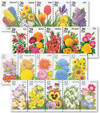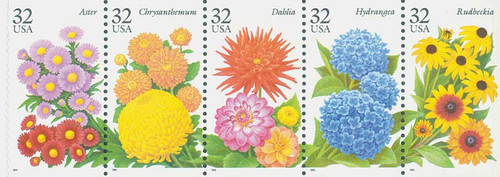
# 2760/3029 - 1993-96 Garden Flowers
U.S. # 2760/3029
1993-96 Garden Flowers Series
· Series of five-stamp booklets picturing garden flowers that bloom in each season.
Stamp Category: Commemorative
Set: Garden Flowers
Value: 29¢-32¢
First Day of Issue:
- Garden Flowers: May 15, 1993
- Summer Garden Flowers: April 28, 1994
- Fall Garden Flowers: September 19, 1995
- Winter Garden Flowers: January 19, 1996
First Day Cities: Spokane, Washington; Cincinnati, Ohio; Encinitas, California; Kennett Square, Pennsylvania
Quantity Issued:
- 1993 Garden Flowers: 199,784,000
- 1994 Summer Garden Flowers: 166,014,000
- 1995 Fall Garden Flowers: 200,000,000
- 1996 Winter Garden Flowers: 160,000,000
Printed by: Bureau of Engraving and Printing
Printing Method: Lithographed, engraved
Format: Booklet panes of 5 stamps each
Perforations:
- Garden Flowers: 10.9
- Summer Garden Flowers: 11.9 vertically
- Fall Garden Flowers: 10.9 vertically
- Winter Garden Flowers: 10.9 vertically
Why the stamps were issued: Part of the push behind these stamps had come from the sale of stamps in supermarkets and other retailers. People had reported that they wanted “bright, pretty American stamps,” so the USPS thought that flower booklets might please the public. They ran TV commercials and full-page advertisements in stamp publications announcing “The flowers are in bloom at your post office. Buy them while they last!” and “Pick up a bunch.”
About the stamp designs: Engraved by the Bureau of Engraving and Printing’s Richard Everett, the stamps featured artwork by Ned Seidler. Seidler had previously designed the 1984 block of four Orchids stamps (US #2076-79). The Garden Flowers stamps depicted a bouquet spread across five stamps, with multiple blooms of each flower contained to each stamp. Using photographs and flower books as his inspiration, Seidler produced his paintings through a combination of watercolor and gouache, a type of thicker watercolor.
Special design details: The Garden Flowers and Summer Garden Flowers booklets have been found with two different errors – missing the black intaglio printing (denomination, USA, and flower name) and imperforate.
About the printing process: The 1993 Garden Flowers booklet was the first to be produced on the new Goebel booklet machine, which was the first to print multicolor covers. The other booklets in the series were also produced on this machine.
First Day City:
- 1993 Garden Flowers: Spokane, Washington at the 55th annual Spokane Lilac Festival and International Lilac Society Convention.
- 1994 Summer Garden Flowers: Greater Cincinnati, Ohio, Flower and Garden Show
- 1995 Fall Garden Flowers: Quail Botanical Gardens in Encinitas, California
- 1996 Winter Garden Flowers: Longwood Gardens, Kennett Square, Pennsylvania
Unusual facts about these stamps: The 1994 Summer Garden Flowers booklet includes a stamp titled “Gladiola.” Some people took issue with this. A member of the Connecticut Gladiolus Society sent a letter to the postmaster general saying that “The correct name is gladiolus, not gladiola. The word gladiolus, singular and plural, has been accepted for more than 50 years by all the local gladiolus societies in the United States and by the North American Gladiolus Council.” The USPS responded that they had simply chosen to go with the more popular “gladiola.”
The 1995 Fall Garden Flowers booklet also received some criticism. Some people noted that depending on where you live in the country, some of these flowers could grow in the summer or even the spring. One USPS representative responded that “The idea with this series was to show a grouping of flowers that would be together somewhere in a garden at the same time. It’s not scientific. It’s meant to be more for mass-market appeal, as opposed to botanical.”
About the Garden Flower Series: This series was borne out of the 1992 Wildflowers issue. Initially, that project had begun when the USPS asked an artist to produce color sketches of a group of garden flowers. Instead, the artist gave the USPS illustrations of wildflowers. The USPS liked them so much, they decided to create a 50-stamp pane, showing wildflowers that can be found in each state. The USPS still liked the garden flowers idea and felt it would also meet consumer demand. Between 1993 and 1996, the USPS issued these booklets of five stamps picturing garden flowers that grow in spring, summer, fall, and winter.
History the stamp represents: Garden flowers are simply cultivated wild flowers that are bred scientifically to have more colorful and attractive blossoms. Originally all flowers were wild and prehistoric people found them growing from the cold wastelands of the Arctic to the steamy jungles of the tropics. Eventually they learned to grow plants and began to raise the prettiest and sweetest smelling flowers in gardens.
Garden flowers can be divided into three main groups: annuals, biennials, and perennials. Annuals are plants that sprout, grow to full size, bloom, produce seeds, and die within one year. Biennials sprout and begin growing within the first year. During the second year they bloom, produce seeds, and then die. Perennials live at least three years. Although they may or may not bloom their first year, once they do bloom many continue to do so indefinitely. The majority of garden flowers are annuals and perennials.
U.S. # 2760/3029
1993-96 Garden Flowers Series
· Series of five-stamp booklets picturing garden flowers that bloom in each season.
Stamp Category: Commemorative
Set: Garden Flowers
Value: 29¢-32¢
First Day of Issue:
- Garden Flowers: May 15, 1993
- Summer Garden Flowers: April 28, 1994
- Fall Garden Flowers: September 19, 1995
- Winter Garden Flowers: January 19, 1996
First Day Cities: Spokane, Washington; Cincinnati, Ohio; Encinitas, California; Kennett Square, Pennsylvania
Quantity Issued:
- 1993 Garden Flowers: 199,784,000
- 1994 Summer Garden Flowers: 166,014,000
- 1995 Fall Garden Flowers: 200,000,000
- 1996 Winter Garden Flowers: 160,000,000
Printed by: Bureau of Engraving and Printing
Printing Method: Lithographed, engraved
Format: Booklet panes of 5 stamps each
Perforations:
- Garden Flowers: 10.9
- Summer Garden Flowers: 11.9 vertically
- Fall Garden Flowers: 10.9 vertically
- Winter Garden Flowers: 10.9 vertically
Why the stamps were issued: Part of the push behind these stamps had come from the sale of stamps in supermarkets and other retailers. People had reported that they wanted “bright, pretty American stamps,” so the USPS thought that flower booklets might please the public. They ran TV commercials and full-page advertisements in stamp publications announcing “The flowers are in bloom at your post office. Buy them while they last!” and “Pick up a bunch.”
About the stamp designs: Engraved by the Bureau of Engraving and Printing’s Richard Everett, the stamps featured artwork by Ned Seidler. Seidler had previously designed the 1984 block of four Orchids stamps (US #2076-79). The Garden Flowers stamps depicted a bouquet spread across five stamps, with multiple blooms of each flower contained to each stamp. Using photographs and flower books as his inspiration, Seidler produced his paintings through a combination of watercolor and gouache, a type of thicker watercolor.
Special design details: The Garden Flowers and Summer Garden Flowers booklets have been found with two different errors – missing the black intaglio printing (denomination, USA, and flower name) and imperforate.
About the printing process: The 1993 Garden Flowers booklet was the first to be produced on the new Goebel booklet machine, which was the first to print multicolor covers. The other booklets in the series were also produced on this machine.
First Day City:
- 1993 Garden Flowers: Spokane, Washington at the 55th annual Spokane Lilac Festival and International Lilac Society Convention.
- 1994 Summer Garden Flowers: Greater Cincinnati, Ohio, Flower and Garden Show
- 1995 Fall Garden Flowers: Quail Botanical Gardens in Encinitas, California
- 1996 Winter Garden Flowers: Longwood Gardens, Kennett Square, Pennsylvania
Unusual facts about these stamps: The 1994 Summer Garden Flowers booklet includes a stamp titled “Gladiola.” Some people took issue with this. A member of the Connecticut Gladiolus Society sent a letter to the postmaster general saying that “The correct name is gladiolus, not gladiola. The word gladiolus, singular and plural, has been accepted for more than 50 years by all the local gladiolus societies in the United States and by the North American Gladiolus Council.” The USPS responded that they had simply chosen to go with the more popular “gladiola.”
The 1995 Fall Garden Flowers booklet also received some criticism. Some people noted that depending on where you live in the country, some of these flowers could grow in the summer or even the spring. One USPS representative responded that “The idea with this series was to show a grouping of flowers that would be together somewhere in a garden at the same time. It’s not scientific. It’s meant to be more for mass-market appeal, as opposed to botanical.”
About the Garden Flower Series: This series was borne out of the 1992 Wildflowers issue. Initially, that project had begun when the USPS asked an artist to produce color sketches of a group of garden flowers. Instead, the artist gave the USPS illustrations of wildflowers. The USPS liked them so much, they decided to create a 50-stamp pane, showing wildflowers that can be found in each state. The USPS still liked the garden flowers idea and felt it would also meet consumer demand. Between 1993 and 1996, the USPS issued these booklets of five stamps picturing garden flowers that grow in spring, summer, fall, and winter.
History the stamp represents: Garden flowers are simply cultivated wild flowers that are bred scientifically to have more colorful and attractive blossoms. Originally all flowers were wild and prehistoric people found them growing from the cold wastelands of the Arctic to the steamy jungles of the tropics. Eventually they learned to grow plants and began to raise the prettiest and sweetest smelling flowers in gardens.
Garden flowers can be divided into three main groups: annuals, biennials, and perennials. Annuals are plants that sprout, grow to full size, bloom, produce seeds, and die within one year. Biennials sprout and begin growing within the first year. During the second year they bloom, produce seeds, and then die. Perennials live at least three years. Although they may or may not bloom their first year, once they do bloom many continue to do so indefinitely. The majority of garden flowers are annuals and perennials.







